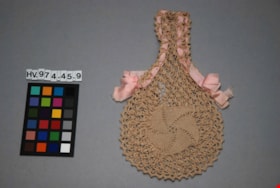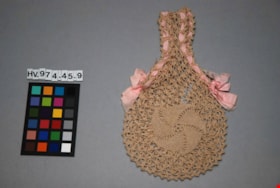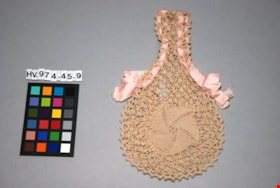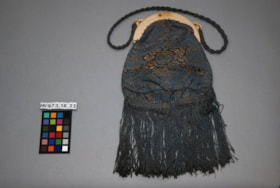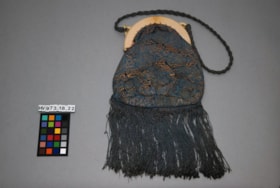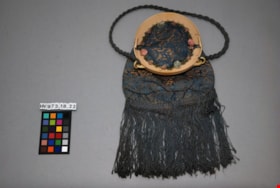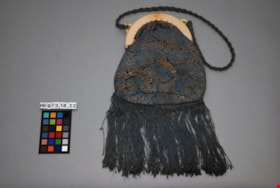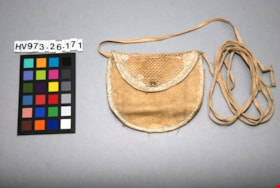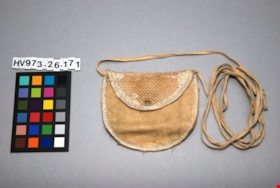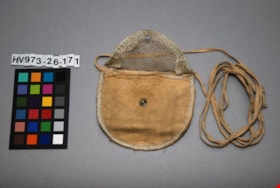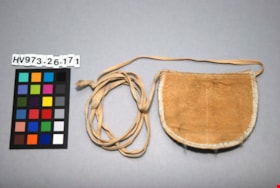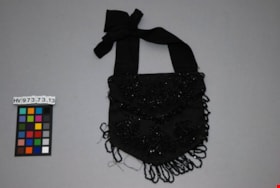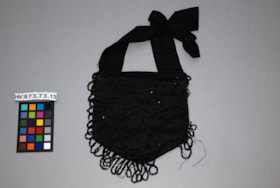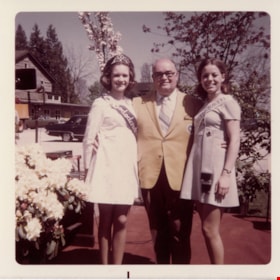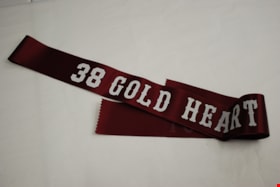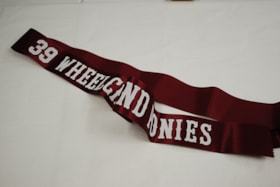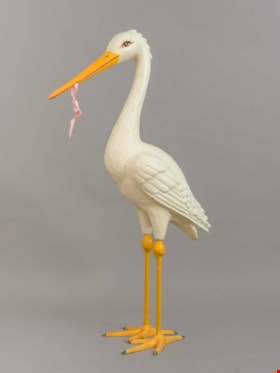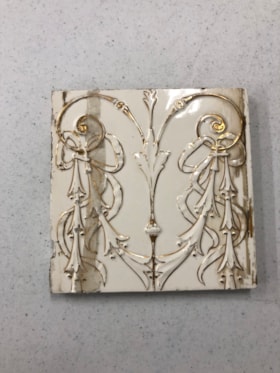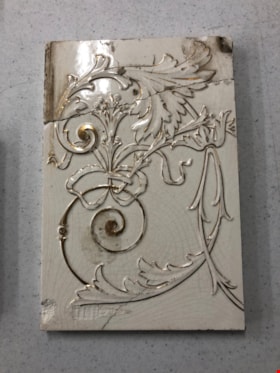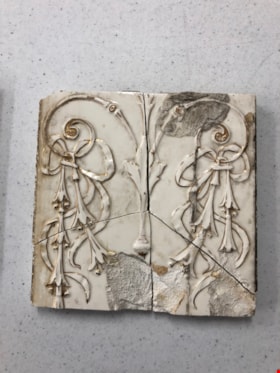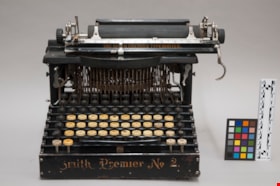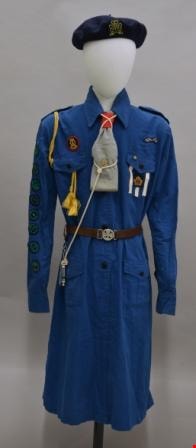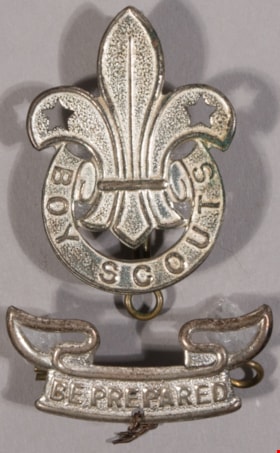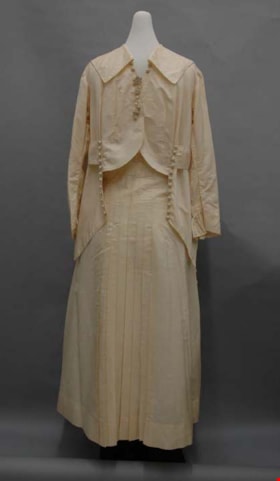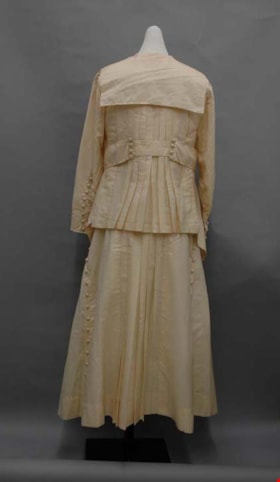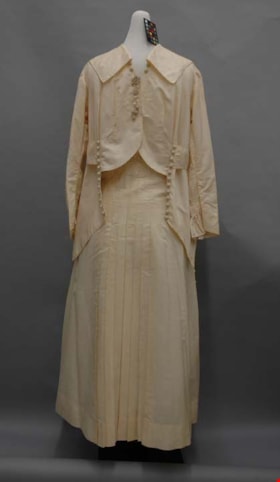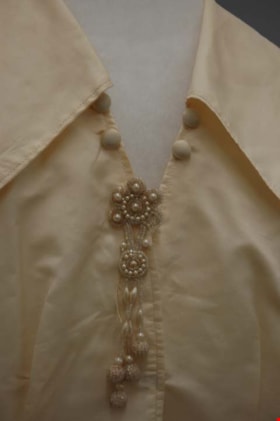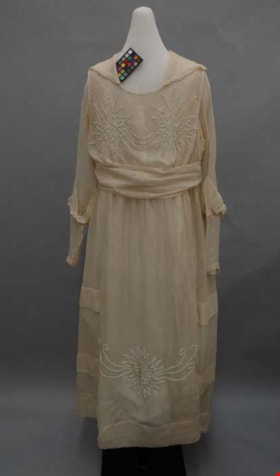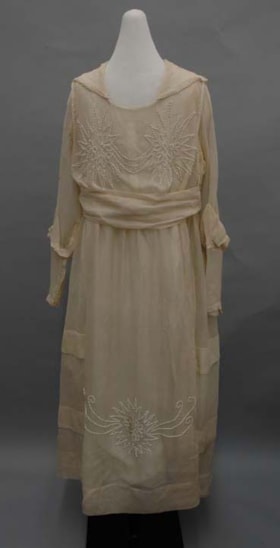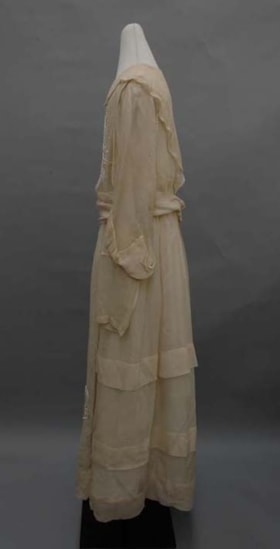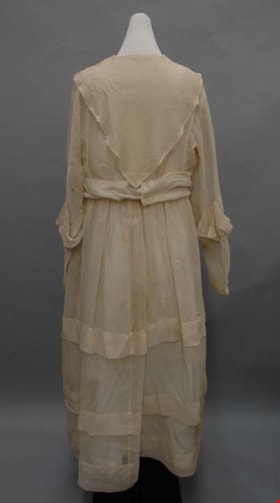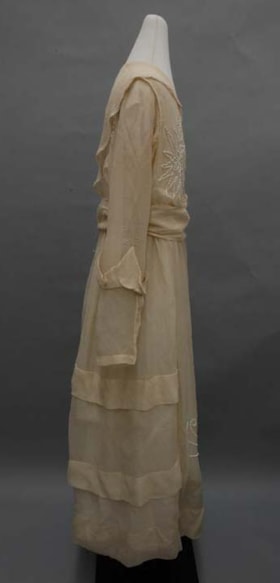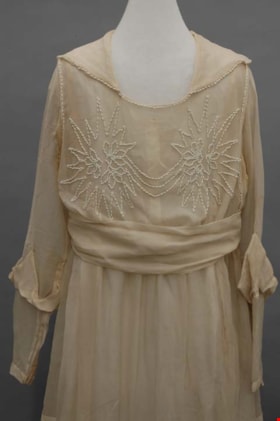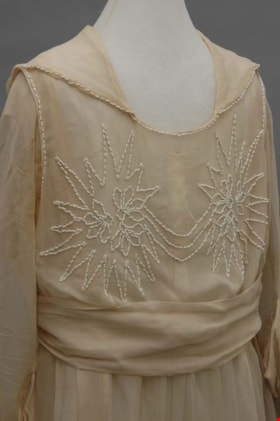Narrow Results By
Subject
- Adornment 11
- Adornment - Lapel Pins 7
- Agriculture 1
- Agriculture - Farms 1
- Animals 1
- Animals - Cats 1
- Building Components 5
- Buildings - Civic - Museums 3
- Buildings - Commercial - Banks 1
- Buildings - Commercial - Department Stores 2
- Buildings - Commercial - Restaurants 1
- Buildings - Commercial - Stores 2
Person / Organization
- Barrington, James Alfred "Jim" 1
- B.C. Summer Games 1
- Bingham, Alfred "Alf" 1
- Boy Scouts of Canada 2
- Brassington, Wayne 1
- Burnaby Centennial '71 Committee 1
- Burnaby Fire Department 1
- Burnaby Historical Society 2
- Burnaby Municipal Police 1
- Burnaby Rhododendron and Spring Flower Show Society 1
- Burnaby Village Museum 9
- Burton, Edgar G. 1
purse
https://search.heritageburnaby.ca/link/museumartifact26714
- Repository
- Burnaby Village Museum
- Accession Code
- HV974.45.9
- Description
- Satchet holder/purse; small flat, crocheted bag with handle; ecru with pink ribbon run through.
- Subjects
- Personal Gear - Purses
- Personal Gear
Images
purse
https://search.heritageburnaby.ca/link/museumartifact28115
- Repository
- Burnaby Village Museum
- Accession Code
- HV973.18.22
- Description
- Purse, blue and gold metallic thread jacquard; fringe; French ivory frame; braided strap; when the frame is opened there is a wreath of ribbon embroidery flowers where the fabric of the purse attaches to the frame.
- Subjects
- Personal Gear - Purses
- Personal Gear
Images
purse
https://search.heritageburnaby.ca/link/museumartifact28321
- Repository
- Burnaby Village Museum
- Accession Code
- HV973.26.171
- Description
- Purse, for change, natural suede with net flap; fastens with a snap; light grey ribbon binding; long twill tape strap.
- Subjects
- Personal Gear - Purses
- Personal Gear
Images
purse
https://search.heritageburnaby.ca/link/museumartifact29857
- Repository
- Burnaby Village Museum
- Accession Code
- HV973.73.13
- Description
- Purse, black silk taffeta; beaded; black ribbon purse strap.
- Subjects
- Personal Gear - Purses
- Personal Gear
Images
Rhododendron Queens with James Barrington
https://search.heritageburnaby.ca/link/museumdescription2082
- Repository
- Burnaby Village Museum
- Date
- May 1971
- Collection/Fonds
- Donald Copan collection
- Description Level
- Item
- Physical Description
- 1 photograph : col. ; 8.9 x 8.9 cm
- Scope and Content
- Photograph of Burnaby Centennial chair James A. Barrington standing together with former Miss Burnaby 1969 Carolyne Lewis (left) and former Miss Burnaby 1970 Melodie Spring (right). The two young women are wearing ribbon sashes with the words "Rhodendron Queen".
- Repository
- Burnaby Village Museum
- Collection/Fonds
- Donald Copan collection
- Series
- Copan album series
- Description Level
- Item
- Physical Description
- 1 photograph : col. ; 8.9 x 8.9 cm
- Scope and Content
- Photograph of Burnaby Centennial chair James A. Barrington standing together with former Miss Burnaby 1969 Carolyne Lewis (left) and former Miss Burnaby 1970 Melodie Spring (right). The two young women are wearing ribbon sashes with the words "Rhodendron Queen".
- Accession Code
- BV005.54.131
- Access Restriction
- No restrictions
- Reproduction Restriction
- May be restricted by third party rights
- Date
- May 1971
- Media Type
- Photograph
- Scan Resolution
- 600
- Scan Date
- July 20, 2020
- Scale
- 100
- Notes
- Title based on contents of photograph
Images
Royal Bank exhibit series
https://search.heritageburnaby.ca/link/museumdescription17800
- Repository
- Burnaby Village Museum
- Date
- 1974-1999
- Collection/Fonds
- Burnaby Village Museum fonds
- Description Level
- Series
- Physical Description
- 127 photographs + 4 cm of textual records
- Scope and Content
- Series consists of records and photographs pertaining to the history, acquistion, restoration, opening and exhibit of the Royal Bank building that was relocated from it's original location at Britannia Beach to Heritage Village (Burnaby Village Museum) in 1976. Fonds is arranged into the following…
- Repository
- Burnaby Village Museum
- Collection/Fonds
- Burnaby Village Museum fonds
- Series
- Royal Bank exhibit series
- Description Level
- Series
- Physical Description
- 127 photographs + 4 cm of textual records
- Scope and Content
- Series consists of records and photographs pertaining to the history, acquistion, restoration, opening and exhibit of the Royal Bank building that was relocated from it's original location at Britannia Beach to Heritage Village (Burnaby Village Museum) in 1976. Fonds is arranged into the following subseries: 1) Royal Bank history and restoration records subseries 2) Royal Bank building photographs subseries 3) Royal Bank exhibit photographs subseries
- History
- The Royal Bank Main Branch Vancouver opened a sub branch operation at Britannia Beach in 1923. The bank provided twice monthly banking service at Britannia Beach and Town site (later named Mt. Sheer) until a permanent branch was established. The new branch building was completed and opened for business on December 1, 1950. The building was designed by bank manager, Mr. Fred Schwab in a simple and traditional design. Since there was no railway and Britannia was only accessible by boat, accommodations for the employees was incorporated into the design. This consisted of two rooms located at the rear of the branch building. The building was furnished with artifacts from the Royal Bank’s central warehouse and soon after with fixtures from the Royal Bank in Nelson including desks and a partition around the manager’s office which was cut down to fit. The bank had two old “Royal Bank of Canada” signs, one hung over the main entrance and the other located over the gable facing Howe Sound. A memorial plaque mounted on the wall inside the bank was one of 1,495 erected in memory of employees of the Royal Bank who died during World War I. The plaque was dedicated to Goldwin William Harron, who worked as a teller at the Royal Bank and was killed in action on July 5, 1916. Goldwin William Harron was born in Kitchener, Ontario in 1897 and later moved to Venn Saskatchewan and enlisted from the Venn Branch of the Royal Bank in October 1915. He first served with the 53rd Battalion and later joined the 28th Battalion. Fred Schwab served as bank manager between December 1, 1950 to August 1956 and Ken Moir served as bank manager from August 1956 until March 1958. When copper prices dropped in 1958, the Howe Sound Mining Co. closed down the mine and many miners and their families left the area. In 1964, Anaconda Mines purchased the Howe Sound Mining Co. and later reopened the mine. After 1958, the Britannia Beach branch continued to be operated as a sub-branch of the Sḵwx̱wú7mesh branch serving Britannia Beach and vicinity until 1974. In 1975, the Royal Bank building was donated to Heritage Village by Anaconda Britannia Mines. On April 24, 1976, the building was transported by barge up Howe Sound to North Vancouver and then up the Fraser River to New Westminster where it was then loaded onto a truck and transported to the Heritage Village site. The building and much of the labour was donated along with $15,000 from the Royal Bank of Canada. The bank safe, oak panelling and some of it’s original furnishings came with the building and were incorporated into the building and the Heritage Village Museum collection. A new building foundation and basement were constructed for the Royal Bank building before it was placed at the south end of Hill Street inside Heritage Village. The basement interior finishing, including wiring and plumbing was undertaken and completed by the Burnaby Centennial Lions Club as a service club charitable project. The Lions Club raised funds for the project and in turn were also granted the use of the completed basement space as a meeting room which they referred to as the “Lion’s Den”. The Royal Bank building and exhibit officially opened on the site of Heritage Village Museum May 23, 1977. The ribbon cutting was done by former bank managers Fred Schwab and Ken Moir. Speakers at the opening ceremony included; Royal Bank representative, M.D. Pollock, President of the Century Park Museum Association, Ted Burnham with closing remarks by Burnaby Mayor, Tom Constable. During the opening ceremony, a presentation of keys for the “Lions Den” was made by Burnaby Centennial Lion’s Club President, Erchil Nordby to Century Park Museum Association President, Ted Burnham and Controller of Anaconda Britannia Mines, Anaconda Canada Ltd. J. MacDonald delivered a speech regarding the donation of the bank building.
- Accession Code
- BV020.5
- BV022.1
- Date
- 1974-1999
- Media Type
- Photograph
- Textual Record
- Architectural Drawing
- Related Material
- Century Park Museum Associaton fonds
- Burnaby Village Museum fonds
- Arrangement
- The majority of the records were created and managed by Heritage Village Museum staff. Records follow the arrangement maintained by both Heritage Village Museum staff (1974-1989) and later, Burnaby Village Museum staff (1990-2020).
- Notes
- Title based on contents of series
- Further accruals are expected
- Some records within this collection are subject to FIPPA
sash
https://search.heritageburnaby.ca/link/museumartifact91015
- Repository
- Burnaby Village Museum
- Accession Code
- BV021.11.17
- Description
- Shoulder sash is made from maroon ribbon with white lettering. The sash is The ends of the sash are pinked. Text on the sash reads: "39 / WHEELCHAIR AND PONIES" printed in white.
- Object History
- The Carousel 100th Anniversary event was held on May 5, 2012 at the Burnaby Village Museum. The items were given out to carousel volunteers who helped restore the carousel when it was brought to BVM. The party was to commemorate the 100 Anniversary of the building of Parker #119 in 1912. The sash was intended to be worn by the sponsor, or their representative, for each horse on the carousel.
- Category
- 03. Personal Artifacts
- Classification
- Clothing - - Clothing Accessories
- Object Term
- Sash
- Measurements
- 7.8 cm wide x 184 cm long
- Names
- Burnaby Village Museum
Images
sash
https://search.heritageburnaby.ca/link/museumartifact91016
- Repository
- Burnaby Village Museum
- Accession Code
- BV021.11.18
- Description
- Shoulder sash is made from maroon ribbon with white lettering. The sash is The ends of the sash are pinked. Text on the sash reads: "38/ GOLD HEART CHARIOT" printed in white.
- Object History
- The Carousel 100th Anniversary event was held on May 5, 2012 at the Burnaby Village Museum. The items were given out to carousel volunteers who helped restore the carousel when it was brought to BVM. The party was to commemorate the 100 Anniversary of the building of Parker #119 in 1912. The sash was intended to be worn by the sponsor, or their representative, for each horse on the carousel.
- Category
- 03. Personal Artifacts
- Classification
- Clothing - - Clothing Accessories
- Object Term
- Sash
- Measurements
- 7.8 cm wide x 184 cm long
- Names
- Burnaby Village Museum
Images
Sea Scout uniform cap tally
https://search.heritageburnaby.ca/link/museumartifact34947
- Repository
- Burnaby Village Museum
- Accession Code
- BV993.17.9
- Description
- Sea Scout cap tally; ribbon; navy blue, yellow writing
- Marks/Labels
- "SEA SCOUTS", yellow, printing
- Subjects
- Organizations
- Organizations - Boys' Societies and Clubs
- Personal Symbols
- Personal Symbols - Ribbons
- Names
- Boy Scouts of Canada
Images
Simpsons-Sears Limited Burnaby fonds
https://search.heritageburnaby.ca/link/museumdescription17413
- Repository
- Burnaby Village Museum
- Date
- 1954-1959, predominant 1954-1955
- Collection/Fonds
- Simpsons-Sears Limited Burnaby fonds
- Description Level
- Fonds
- Physical Description
- 114 photographs + 15 cm of textual records
- Scope and Content
- Fonds consists of photographs and textual records from a scrapbook documenting the early years of the Simpsons-Sears store located at 3660 Kingsway (after 1959 - 4750 Kingsway) in Burnaby including the opening day and staff events. Many of the photographs depict, Manager of Simpsons-Sears, Burnaby,…
- Repository
- Burnaby Village Museum
- Collection/Fonds
- Simpsons-Sears Limited Burnaby fonds
- Description Level
- Fonds
- Physical Description
- 114 photographs + 15 cm of textual records
- Scope and Content
- Fonds consists of photographs and textual records from a scrapbook documenting the early years of the Simpsons-Sears store located at 3660 Kingsway (after 1959 - 4750 Kingsway) in Burnaby including the opening day and staff events. Many of the photographs depict, Manager of Simpsons-Sears, Burnaby, T. Boyd Haskell and include photographs regarding activities of the Greater Vancouver Tourist Association in which T. Boyd Haskell was president 1958-1959. Textual records within fonds include a financial ledger (1954-1956) as well as congratulatory telegrams and cards addressed to Simpsons-Sears staff and managers regarding the Simpsons-Sears store opening in May 1954 along with lists of names of Simpsons-Sears and Sears-Roebuck executive members who visited the store. Records are arranged into the following series: 1) Simpsons-Sears scrapbook series 2) Burnaby Simpsons-Sears adminstrative records series
- History
- In 1952, U.S. Chairman of Sears-Roebuck and Company, General Robert E.Wood, contacted President of Robert Simpson Company, Edgar G. Burton proposing a partnership between the two companies to serve the Canadian retail market. In September 1952, a merger was signed between the two to create Simpsons-Sears Limited. The terms of the agreement were 50-50. The two main objectives were to expand the Simpsons’ mail order business which was sold to the new company and to build new retail stores across Canada that were modelled on the Sears, Roebuck’s design. In early 1953, operations began with the first Simpsons-Sears Spring/Summer catalogue that was delivered to 300,00 homes across Canada. In September 1953, the first Simpsons-Sears retail store opened in Stratford Ontario and in December 1953 the second store opened in Kamloops, B.C. In 1953, with a 7.6 million dollar investment, construction began on the Simpsons-Sears store located at 3660 Kingsway in Burnaby. This was the second Simpsons-Sears store to be built in British Columbia. The store was designed by two Vancouver architectural firms Sharp, Thompson, Berwick and Pratt and Gardiner and Thornton. The new Burnaby Simpsons-Sears was touted as the most modern mall in Canada with the facing of the store consisting of Travertine marble imported from Italy and the main floor included fourty eight miles of brass strips incorporated in the terrazzo floor which was made from marble chips mixed with white Portland concrete. An exterior promenade, built from British Columbia fir and bolted with copper and brass was built around the exterior of the store. The promenade provided an outdoor display area for garden furniture and other large items. The retail store officially opened on May 5, 1954 with Simpsons-Sears executive members, managers and the Reeve of Burnaby in attendance. T. Boyd Haskell, from Spokane, Washington was hired as the Burnaby retail store manager and C.W. Jaggs, former Simpsons' general manager for British Columbia became manager of the Simpsons-Sears mail order business in British Columbia. A ribbon cutting ceremony took place during the opening event with Burnaby Reeve Charles W. MacSorley in attendance along with other dignitaries from Simpsons-Sears including President of Simpsons-Sears, E.G. Burton; Chairman of the board of Simpsons-Sears, Charles W. Burton; Vice President of Simpsons-Sears, G.F. Trotter; Mail Order Manager for Simpsons-Sears, B.C., C.W. Jaggs and Manager of Simpsons-Sears, Burnaby, T. Boyd Haskell. Over 10,000 people attended the opening of the store at 11:00 a.m. and it is believed that throughout the day, over 75,000 people went through the new store. T. Boyd Haskell was manager of the Burnaby Simpsons-Sears store between 1953 and 1962. After graduating from college, Haskell joined the Sears-Roebuck department store chain. In 1953 he moved to Vancouver from Washington State to set up the new store in Burnaby. In 1962, Haskell left Simpsons-Sears in Burnaby and transferred to the Sears store in Los Angeles. During his time in British Columbia, Haskell served as the President of the Greater Vancouver Tourist Association (1958-1959), President of the Community Chest and Councils of Greater Vancouver (1960) and was also a member of the board of directors of the B.C. Lions football team. Haskell died in Arizona in 1969 at the age of 54 years. In 1978, the Hudson’s Bay Company purchased “Simpsons” and converted many of the department stores into The Bay, including the store in downtown Toronto. Sears stores continued to carry the name “Simpsons-Sears” until 1984 when the named changed to “Sears Canada”. The Simpsons-Sears store (later named "Sears") located at 4750 Kingsway (Metropolis at Metrotown) closed it's doors in 2018.
- Creator
- Simpsons-Sears Limited
- Accession Code
- BV021.26
- BV022.17
- Date
- 1954-1959, predominant 1954-1955
- Media Type
- Photograph
- Textual Record
- Related Material
- See also: memorial program for T.B. Haskell in Burnaby Village Museum artifact collection BV021.26.166
- Arrangement
- Arrangement of records is based on original order of scrapbook and financial ledger by creator(s). Photographs and textual records were described in the order that they were arranged within original scrapbook prior to being removed.
- Notes
- Title based on contents of fonds
stork figure
https://search.heritageburnaby.ca/link/museumartifact79138
- Repository
- Burnaby Village Museum
- Accession Code
- BV007.9.4
- Description
- The stork's body is made of paper mache. It is painted white with a yellow beak and elaborate eyelashes. There is a pink ribbon in a slot in the beak. There was originally a balance scale held in the beak. The legs are wood painted yellow the feet are cast iron to make the figure stand. The body lifts off of the legs. There is no noticeable damage. There are no makers marks.
- Object History
- Made for Helen's Children's Wear in early 1950's by Nettie Trainer, the mother of the store owner, Helen Arnold (nee Trainer). It was handmade. Nettie Trainer was a well known maker of custom figures for commercial displays. Helen's Children's Wear was located at 4142 Hastings Street. Owner Helen Arnold opened the store on East Hastings Street in 1948. She moved to the 4142 Hastings Street location in 1955, and added a landmark neon sign to the building in 1956. The sign featured a girl on a swing, and served as an important landmark in the neighbourhood. The store closed in 2007.
- Measurements
- Overall measurements Lth 75 cm. Wth 30 cm. Ht 136 cm.
- Names
- Helen's Childrens Wear
Images
Tile
https://search.heritageburnaby.ca/link/museumartifact90825
- Repository
- Burnaby Village Museum
- Accession Code
- BV020.40.16
- Description
- White ceramic tile with gold design. The design is made up of a gold line down the centre with a leaf comprising the top half. Two gold curls emerge from either side of the line. Six bell-shaped flowers hang from these gold curls on each side and are tied with a ribbon. There is a brown stain down either side.
- Object History
- These tiles are from Glenedward Mansion, built in 1912. It was built at 3412 Kingsway, which later became 5152 Kingsway. They were salvaged when the mansion was demolished in the 1990s.
- Category
- 01. Built Environment Objects
- Classification
- Building Components - - Surface Elements
- Object Term
- Tile, Decorative
- Colour
- White
- Gold
- Measurements
- 6" x 6"
- Subjects
- Building Components
- Buildings - Heritage
- Historic Neighbourhood
- Edmonds (Historic Neighbourhood)
- Planning Study Area
- Windsor Area
Images
Tile
https://search.heritageburnaby.ca/link/museumartifact90830
- Repository
- Burnaby Village Museum
- Accession Code
- BV020.40.19
- Description
- White ceramic tile with gold design. The design is made up of two flowers attached to a gold curled tendril. At the top, a large flower follows the curled line. the line conitnues out of the centre of the flower and splits into two leafy tendrils. One of the leaves has a thick gold curl coming from it. A ribbon with a flower is tied to this gold curl (nearest to the bottom of the tile), and has six stamens coming from the flower. The tile has a wiggled split in the top quarter of the tile, bisecting the large flower.
- Object History
- These tiles are from Glenedward Mansion, built in 1912. It was built at 3412 Kingsway, which later became 5152 Kingsway. They were salvaged when the mansion was demolished in the 1990s.
- Category
- 01. Built Environment Objects
- Classification
- Building Components - - Surface Elements
- Object Term
- Tile, Decorative
- Colour
- White
- Gold
- Measurements
- 8" h x 6" w
- Subjects
- Building Components
- Buildings - Heritage
- Historic Neighbourhood
- Edmonds (Historic Neighbourhood)
- Planning Study Area
- Windsor Area
Images
Tile
https://search.heritageburnaby.ca/link/museumartifact90836
- Repository
- Burnaby Village Museum
- Accession Code
- BV020.40.21
- Description
- White ceramic tile with gold design. The design is made up of a gold line down the centre with a leaf comprising the top half. Two gold curls emerge from either side of the line. Six bell-shaped flowers hang from these gold curls on each side and are tied with a ribbon. There is a large brown stain on the top right corner with two rough chips out of the bottom. This tile is split into nearly 4 equal parts.
- Object History
- These tiles are from Glenedward Mansion, built in 1912. It was built at 3412 Kingsway, which later became 5152 Kingsway. They were salvaged when the mansion was demolished in the 1990s.
- Category
- 01. Built Environment Objects
- Classification
- Building Components - - Surface Elements
- Object Term
- Tile, Decorative
- Colour
- White
- Gold
- Measurements
- 6" x 6"
- Subjects
- Building Components
- Buildings - Heritage
- Historic Neighbourhood
- Edmonds (Historic Neighbourhood)
- Planning Study Area
- Windsor Area
Images
typewriter
https://search.heritageburnaby.ca/link/museumartifact83395
- Repository
- Burnaby Village Museum
- Accession Code
- BV007.30.1
- Description
- Full-keyboard upstrike Smith Premier No. 2 typewriter made by Smith Premier Typewriter Company, 1904. It features a double keyboard, with rows of lowercase letters at the bottom and uppercase letters at the top. It includes typewriter, carrying lid, wooden platform, two typewriter ribbon spools, and an unrelated box that holds the spools.
- Object History
- Donor found object in an old building in Vancouver, ca. late 1950's - early 1960's. Smith Premier manufactured double keyboards until 1921, long after their competitors had introduced the "Shift" key which allowed each key to type both an upper and lowercase letter.
- Reference
- http://www.typewritermuseum.org/collection/index.php3?machine=smithpr1&cat=ku
- Country Made
- United States of America
- Province Made
- New York
- Site/City Made
- Syracuse
- Subjects
- Written Communication Tools and Equipment
- Written Communication Tools and Equipment - Typewriters
Images
uniform dress
https://search.heritageburnaby.ca/link/museumartifact87413
- Repository
- Burnaby Village Museum
- Accession Code
- BV015.36.62
- Description
- Uniform dress – long-sleeve blue cotton uniform dress, four (4) black buttons with GGC & trefoil logo down front of dress, two breast flap pockets with brown button closures, two hip flap pockets with black button closures, two tab epaulets at shoulders with black button closures, tag inside collar reads: “OFFICIAL UNIFORM / GIRL GUIDES / ASSOCIATION / STORES DEPARTMENT / TORONTO, CANADA”. Wings (Brownie) sewn above left pocket. 2 year star with brown felt backing pinned to left pocket flap. Salvation Army Badge sewn on left pocket front. Three white stripes of adhesive cloth tape applied vertically to the front of the left breast pocket. Two B.C. Provincial Hat badges are pinned to the left collar point (these would not normally be worn on the uniform itself). Religion in Life badge (yellow alpha & omega symbols) sewn above right breast pocket. Gold Cord worn threaded through the right tab epaulet of the uniform dress and then hooked behind the button of the right breast pocket flap. Badges sewn vertically on right sleeve include: Woodcraft emblem (silver tree on right shoulder epaulet), must earn a group of other badges to get woodcraft emblem (outdoor activities); Little House emblem (Queen Elizabeth II’s doll house at top of right sleeve), must earn a group of other badges to get little house emblem (indoor activities); Hostess (green teacup & saucer), Laundress (green iron), Musician (green lyre), Fitness Fun (green figure with arms raised), Life Skills (green crossed keys), Sport (green figure with jump rope) Sewing (green scissors), Citizen (green maple leaf), Cook (green gridiron), Health (green serpent), Singing (green music staff with notes G, B, and D), Postal (green winged envelope), Writing (green feather quill & inkpot), Knitter (green yarn ball & needles), Reporting (green feather pen & paper), Fire Safety (green firefighter’s helmet), Swimming (green life preserver), Pioneer (green crossed pick & axe), Hiking (green Viking helmet woodcraft sign), Forestry (green deciduous tree), Astronomy (green Great Bear constellation), Camper (green tent) and Tracker (green rabbit tracks). Badges sewn vertically on left sleeve include: First Class Emblem (red ribbon of courage as border tying into a reef knot at bottom); Home Nurse (white cross), Child Care (green cross) and First Aid (red cross).
- Object History
- Salvation Army Guide uniform dress belonging to Virginia Blake, early 1960s. From the 6th Vancouver Salvation Army Guides on Hastings Street. Salvation Army was affiliated with Girl Guides (1937) of Canada until 1998. Worn with brown leather belt, beret, folded triangular company tie. The three white stripes on the right breast pocket indicate that wearer was a company leader. The more stripes you had, the higher your rank. A single white stripe, sewn down the center of the pocket, would have indicated that she was a patrol seconder. Two stripes would indicate that she was a patrol leader. White adhesive tape was used so that the Guider didn’t have to unstitch and re-sew the stripes as they gained rank.
- Category
- 03. Personal Artifacts
- Classification
- Clothing
- Clothing - - Main Garments
- Names
- Girl Guides of Canada
Images
uniform hat badge
https://search.heritageburnaby.ca/link/museumartifact41587
- Repository
- Burnaby Village Museum
- Accession Code
- BV001.6.10
- Description
- Badge, Boy Scout patrol leader's, for hat; in two pieces; "Boy Scouts"; split pin fastening; fleur-de-lis shape; lower part is ribbon motif, "Be Prepared" ; pre 1942
- Object History
- This badge was worn by the donor as a patrol leader prior to 1942.
- Names
- Boy Scouts of Canada
Images
Vancouver Daily Province pioneer's honour roll certificate
https://search.heritageburnaby.ca/link/museumdescription17531
- Repository
- Burnaby Village Museum
- Date
- 1 Jun. 1929
- Collection/Fonds
- Dorothy Atkinson fonds
- Description Level
- Item
- Physical Description
- 2 p.
- Scope and Content
- File consists of a Vancouver Daily Province, Pioneer's Certificate, Roll of Honour awarded to Mr. and Mrs. Percy Mallett on June 1, 1929 and signed by managing director, F.J. Burd along with the mailing tube cover addressed to Mr. and Mrs. Mallett, 3965 Cambridge Street, Vancouver. Certificate decl…
- Repository
- Burnaby Village Museum
- Collection/Fonds
- Dorothy Atkinson fonds
- Description Level
- Item
- Physical Description
- 2 p.
- Material Details
- gold seal and ribbon adhered to surface
- Scope and Content
- File consists of a Vancouver Daily Province, Pioneer's Certificate, Roll of Honour awarded to Mr. and Mrs. Percy Mallett on June 1, 1929 and signed by managing director, F.J. Burd along with the mailing tube cover addressed to Mr. and Mrs. Mallett, 3965 Cambridge Street, Vancouver. Certificate declares that the Malletts arrived in Vancouver in 1909. These certificates were awarded and mailed to three thousand people who were regular readers of the Vancouver Province newspaper for twenty years or more.
- Subjects
- Documentary Artifacts - Certificates
- Accession Code
- BV021.28.16
- Access Restriction
- No restrictions
- Reproduction Restriction
- No known restrictions
- Date
- 1 Jun. 1929
- Media Type
- Textual Record
- Scan Resolution
- 600
- Scan Date
- 2021-10-04
- Scale
- 100
- Notes
- Title based contents of item
Images
wedding dress
https://search.heritageburnaby.ca/link/museumartifact3348
- Repository
- Burnaby Village Museum
- Accession Code
- BV989.39.1
- Description
- Wedding dress, 1917. Cream silk, jacket and skirt. Sailor collar, long sleeves, loose cut with fitting, beaded brooch, pleats and button trim on both pieces. The V neck has a large square sailor style collar, with two self covered ball buttons on either side just below the collar ends. At the V point there is a beaded floral brooch with tassels. The sleeves are loose fitting, trimmed with eight buttons at the forearm and gathered to half a cuff. The centre front of the bodice has a bust dart on either side, and cuts off at the waist. Here a belt attaches around the sides, trimmed with four buttons at either side front and back. The bodice's ivory silk lining is not pleated, and it is not attached at the bottom. It closes at centre front with two slide snaps. On the back of the jacket, there is a large pleat on either side. Centre back is fully pleated, and the pleats are sewn down from the neckline to underarm level. At the waistline, there is a narrower band of fabric that joins the side belts together and holds the pleats in place. The back of the jacket extends to the hips, and the sides extend several inches further and each end in a point. The skirt, made with six gores, falls smoothly over the hips. It has a pleated ruffle at the top and a waistband reinforced with a large grosgrain ribbon on the inside. The centre back and centre front are pleated from the waist to hem, the pleats sewn down to the end of the hips. Each side is trimmed with buttons spaced evenly from the waist to hem. The skirt closes at the right side back with slide snaps and hooks and eyes on the grosgrain.
- Object History
- Photocopy of the original wedding photo is in the acquisition file. Worn by the donor's mother, Mary Edith Pearl Collum (nee Dillabough). She married Eli Wilbert Collum on June 20, 1917, in Winnipeg (she was 25 years old). They moved to Vancouver in 1936, then to Burnaby in 1938. Edith gave the dress to her son first for safe keeping, and then as an inheritance. She passed away February 1, 1989 at age 97 (born 1892).
- Subjects
- Clothing
- Clothing - Costumes
Images
wedding dress
https://search.heritageburnaby.ca/link/museumartifact30794
- Repository
- Burnaby Village Museum
- Accession Code
- HV972.5.4
- Description
- Wedding dress, c.1913. The fabric is an ivory silk chiffon, lined in white satin silk. The skirt extends mid-calf, the sleeves three-quarter length, and there is white beaded decoration on the bottom front of the skirt, as well as the front of the bodice. The silhouette of this dress shows the then fashionable shape of a raised waistline, as well as the poufed blouse front that was still popular. The fabric is light, flowy, and airy, but the cut has straight lines in features such as the bodice panels and large skirt pin tucks. The bodice closes via a panel that hangs down the front, attaches to the waist, and extends down the bodice back. There is an additional panel that attaches on each side front neck, forming a collar, and hangs down the back in a triangular shape. The front panel closes on the left side at the waist and at the left shoulder with snaps. There are two beaded floral starburst patterns, one each on the left and right side of the front bodice panel, connected with three curved lines. There is also a single line of white beads along the edges of the front bodice panel, and both back panels, including the front and side neck. The sleeves connect to the dress lining under the bodice panels. Each has a hanging panel around the elbow line which looks like four triangle shapes that point upwards, tacked above the elbow line. The cuffs are narrowed with a dart and two pin tucks, with a hook and eye closure on a bound placket. Around the waist, there is a belt that connects to itself with snaps, and is tacked to the waistline in the centre back. There are two snaps on the left side waist that may have once been used to secure the belt, but the belt no longer has any corresponding snaps. The skirt is somewhat gathered at the waist, more in the back than the front, and consists of three slightly flared gores. The front gore is plain except for a white beaded floral starburst motif near the bottom front. Three beaded tendril lines extend from either side, spanning the width of the front gore. The other two gores each extend from the side fronts to the centre back; they each have two three inch pin tucks, just above knee level and one below, that hang downwards and extend to centre back. The lining is attached at the waist, and hangs freely under the skirt. It has a front and back gore, as well as two triangular gores on each side starting at knee level. In the bodice it is attached at the neck and shoulders, where it attaches to the unlined sleeves. It closes on the left front with hooks and eyes. Inside the lining, the waist is reinforced with three inch cotton grosgrain ribbon which closes at centre front with hooks and eyes. The dress is sewn mainly by machine with french seams, although the four inch hem is hand sewn with a whip stitch. The sleeve pin tucks are also hand sewn. The length of the skirt lining was reduced just above its hem with a one inch hand stitched tuck.
- Subjects
- Clothing
- Clothing - Costumes
